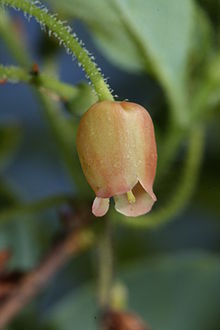- Menziesia ferruginea
-
Menziesia ferruginea Scientific classification Kingdom: Plantae (unranked): Angiosperms (unranked): Eudicots (unranked): Asterids Order: Ericales Family: Ericaceae Genus: Menziesia Species: M. ferruginea Binomial name Menziesia ferruginea
Sm.Menziesia ferruginea is a species of flowering plant in the heath family known by several common names, including rusty menziesia, false huckleberry, and mock azalea. It is native to northwestern North America from Alaska through the Pacific Northwest to Wyoming, where it is a member of the flora in mountain forests. It grows in the understory of subalpine fir (Abies lasiocarpa), Pacific silver fir (A. amabilis), western redcedar (Thuja plicata), western hemlock (Tsuga heterophylla), and other conifers.[1] The plant prefers cold, wet, densely vegetated areas where it can grow in deep shade.[1]
This is a mostly erect or spreading shrub often exceeding 3 meters in height, reaching shorter maximum heights at higher elevations.[1] Its branches are coated in thin, scaly, shreddy bark and its twigs with fine glandular hairs. The alternately arranged deciduous leaves are oval in shape with pointed tips, reaching 4 to 6 centimeters long. The leaves are hairy, glandular, and sticky in texture, and have an unpleasant skunklike odor when crushed.[1] The inflorescence is a loose cluster of hanging bell- or cup-shaped flowers in shades of pink to orange to yellow-green. The flower has 4 to 5 petals which are mostly fused into a cylinder, and eight stamens inside. The fruit is a valved capsule under a centimeter long which contains many seeds.
References
External links

This Ericaceae article is a stub. You can help Wikipedia by expanding it.

